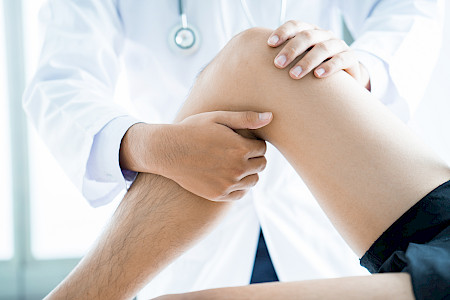Meniscus Injuries
When the Knee’s Shock Absorber Tears
The meniscus is a piece of cartilage that cushions the knee joint. A tear here can cause pain, swelling, or a “catching” sensation in the knee.
Why the Meniscus Matters
Each knee has two menisci, C-shaped pieces of cartilage that act like shock absorbers between the thigh bone and shin bone. They help distribute weight, stabilise the joint, and protect the knee from wear and tear. When a meniscus tears, the knee loses some of this cushioning.
Common Causes of Meniscus Tears
Meniscus injuries can happen suddenly or develop gradually:
- Sports injuries: twisting the knee while it’s bent or planted
- Everyday movements: squatting, kneeling, or lifting awkwardly
- Age-related changes: meniscus becomes weaker and more prone to tearing
- Accidents or trauma: falls, collisions, or direct impact on the knee
Symptoms That May Point to a Meniscus Injury
Not every meniscus tear feels the same, but common signs include:
- Knee pain, especially when twisting or squatting
- Swelling or stiffness in the joint
- Clicking, catching, or locking of the knee
- Feeling like the knee is “giving way”
- Limited ability to fully straighten or bend the knee
How Doctors Diagnose Meniscus Injuries
Because knee pain has many causes, proper diagnosis is important. Assessment may include:
- Physical examination: testing movement, stability, and tenderness
- Imaging: MRI scans are most accurate for detecting meniscus tears
- Arthroscopy: in some cases, a keyhole procedure to confirm and treat the tear
Treatment Options for Meniscus Tears
Treatment depends on the size, type, and location of the tear:
- Rest and lifestyle changes: avoiding activities that worsen pain
- Medications: to reduce swelling and discomfort
- Physiotherapy: strengthening muscles to support the knee
- Injections: for pain relief in selected cases
- Surgery: arthroscopic repair (stitching the meniscus) or partial removal (meniscectomy) if symptoms persist
Living with a Meniscus Injury
A torn meniscus can make daily activities, from walking to sports, frustrating. Early treatment helps preserve knee health and prevents further wear-and-tear arthritis. Staying active with low-impact exercises like swimming or cycling may help until treatment is complete.
Frequently Asked Questions (FAQ)
1. Can a meniscus tear heal on its own?
Small tears at the outer edge (where blood supply is better) may heal with rest. Larger or inner tears usually require surgical treatment.
2. What’s the difference between meniscus repair and removal?
Repair stitches the cartilage back together, while removal trims the torn portion. Repair is preferred if possible to preserve knee function.
3. How do I know if my knee is locking because of a meniscus tear?
If your knee sometimes gets stuck and won’t fully straighten, it may be due to a torn meniscus flap catching in the joint.
4. How long is recovery after meniscus surgery?
Recovery varies: partial removal may take a few weeks, while repairs may need several months with physiotherapy.
5. Can untreated meniscus tears cause arthritis?
Yes, a torn meniscus increases joint stress, which can accelerate wear and lead to arthritis over time.
Book a Consultation for Knee Pain or Meniscus Injury
If you have ongoing knee pain, swelling, or locking, book an appointment at Mash Spine & Orthopaedics for diagnosis and treatment options.





